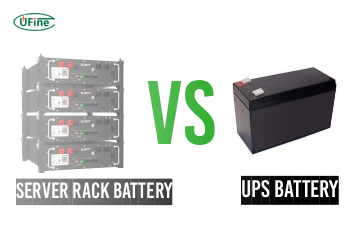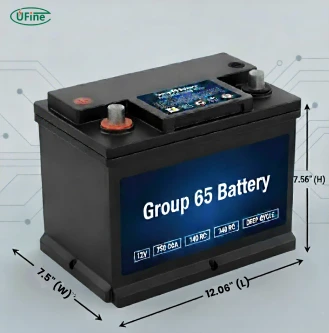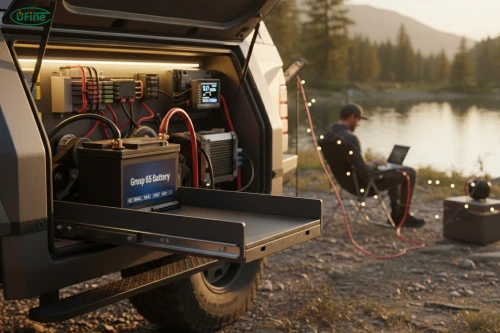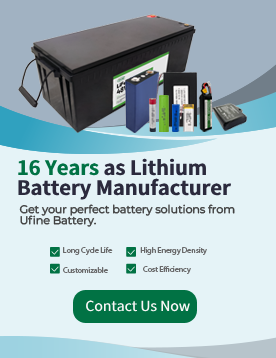
- Part 1. What is a group 65 battery?
- Part 2. Voltage and capacity
- Part 3. Battery types
- Part 4. Group 65 battery dimensions & weight
- Part 5. Price comparison
- Part 6. Best group 65 batteries (2025 edition)
- Part 7. Buying guide: How to choose the right group 65 battery
- Part 8. Common applications
- Part 9. Lifespan of group 65 batteries
- Part 11. Conclusion
- Part 10. FAQs
If you drive a truck, SUV, or heavy-duty vehicle, having a powerful and long-lasting battery is crucial. Among all automotive battery sizes, the Group 65 battery stands out for its high cold cranking amps, durability, and reliability under demanding conditions.
In this complete guide, we’ll cover everything you need to know about Group 65 batteries — their size, voltage, types, and lifespan — plus a full comparison of the best Group 65 batteries in 2025, including price, performance, and brand recommendations.
Part 1. What is a group 65 battery?
A Group 65 battery refers to a specific size classification standardized by the Battery Council International (BCI). The “65” indicates the physical dimensions of the battery case — approximately 12.06″ (L) × 7.5″ (W) × 7.56″ (H) — not its voltage or capacity.
This group size is mainly designed for:
- Trucks and SUVs
- Diesel vehicles
- Heavy-duty and off-road equipment
Advantages
- ✅ High Cold Cranking Amps (CCA): Reliable starting power in cold weather.
- ✅ Durable Construction: Built to handle vibrations and shocks from heavy-duty use.
- ✅ Long Lifespan: AGM and lithium batteries can last years longer than conventional lead-acid models.
Disadvantages
- ⚠️ Heavier weight than smaller battery groups.
- ⚠️ Higher cost for AGM or lithium models.
Still, for drivers who need dependable performance in harsh environments, Group 65 batteries are one of the best investments available.
Part 2. Voltage and capacity
Like most automotive batteries, Group 65 batteries deliver 12 volts — enough to start large engines and power high-demand electronics such as infotainment systems, winches, or towing equipment.
Typical capacity ranges from 70Ah to 90Ah, ensuring long-lasting power for vehicles with multiple electrical components. For off-road or outdoor users who run lights or accessories when the engine is off, this extra capacity is a big advantage.
Part 3. Battery types
Group 65 batteries come in three main types. Each has unique benefits depending on your needs and budget.
| Type | Description | Pros | Cons |
|---|---|---|---|
| Flooded Lead-Acid | Traditional design with liquid electrolyte. | Low cost, widely available. | Requires maintenance, risk of spills. |
| AGM (Absorbent Glass Mat) | Electrolyte absorbed in fiberglass mats. | Maintenance-free, vibration-resistant, long life. | More expensive than flooded. |
| Lithium-Ion | Advanced chemistry offering lightweight and high energy density. | Longest lifespan, fast charging, lightweight. | Highest upfront cost. |
AGM vs Lithium vs Lead-Acid — Which Is Best?
- For budget buyers, flooded lead-acid is affordable but needs regular maintenance.
- For daily drivers and trucks, AGM offers the best balance of performance and durability.
- For maximum lifespan and minimal weight, lithium Group 65 batteries are the ultimate choice.
AGM VS Lithium VS Lead-Acid Battery: Comprehensive Comparison
Part 4. Group 65 battery dimensions & weight
A Group 65 battery typically measures 12.06″ × 7.5″ × 7.56″, and weighs between 40–60 lbs.
AGM and lead-acid versions are heavier, while lithium types can be up to 40% lighter — a major benefit for users who value efficiency and easy installation.
Always confirm your vehicle’s fitment before purchase. Using the wrong size may cause fitting or terminal connection issues.
Part 5. Price comparison
Pricing varies depending on battery chemistry and brand:
| Type | Typical Price Range | Lifespan | Maintenance |
|---|---|---|---|
| Flooded Lead-Acid | $100–$150 | 3–5 years | Regular water checks |
| AGM | $150–$250 | 5–7 years | Maintenance-free |
| Lithium-Ion | $300–$500+ | 8–10 years | Maintenance-free |
Though lithium batteries have a higher upfront cost, they offer the lowest lifetime cost due to their long service life and stable performance.
Part 6. Best group 65 batteries (2025 edition)
Here are the most recommended Group 65 batteries on the market in 2025, based on performance, reliability, and customer feedback.
| Brand & Model | Type | CCA | Capacity (Ah) | Warranty | Price | Best For |
|---|---|---|---|---|---|---|
| Odyssey 65-PC1750T | AGM | 950 | 74 | 3–4 yrs | ~$300 | Heavy-duty trucks |
| Optima RedTop 8004-003 | AGM | 770 | 65 | 3 yrs | ~$250 | Cold-weather reliability |
| DieHard Gold 65-2 | Lead-acid | 850 | 75 | 2 yrs | ~$160 | Budget-friendly vehicles |
| NorthStar NSB-AGM65 | AGM | 930 | 70 | 4 yrs | ~$320 | Long lifespan & vibration resistance |
| Ufine Lithium 12V 65 | Lithium-ion | 1000+ | 85 | 5–10 yrs | ~$400+ | Lightweight, high-performance use |
Each model offers excellent durability and power output for large engines, making them ideal for trucks, SUVs, and off-road vehicles.
Part 7. Buying guide: How to choose the right group 65 battery
When deciding which Group 65 battery to buy, consider the following:
1 Vehicle Type:
- Diesel trucks or off-road vehicles → AGM or Lithium recommended.
- Standard cars or older SUVs → Flooded lead-acid may suffice.
2 Climate:
- Cold regions → High CCA rating (≥850).
- Hot regions → AGM or lithium (resists heat degradation).
3 Usage Frequency:
- Daily driving → AGM is the best all-round choice.
- Occasional use or long-term storage → Lithium holds charge longer.
4 Budget:
- Short-term savings → Flooded type.
- Long-term investment → Lithium or AGM.
Part 8. Common applications
Group 65 batteries are widely used in:
- Heavy-duty trucks and SUVs
- Diesel engines and off-road vehicles
- RVs and campers
- Industrial or marine equipment
They deliver consistent 12V power even in tough environments with frequent vibration and temperature extremes.
Part 9. Lifespan of group 65 batteries
Battery life varies depending on type and maintenance level:
| Battery Type | Average Lifespan |
|---|---|
| Flooded Lead-Acid | 3–5 years |
| AGM | 5–7 years |
| Lithium-Ion | 8–10 years+ |
To maximize lifespan:
- Keep terminals clean.
- Avoid deep discharges.
- Store in a cool, dry environment.
Part 11. Conclusion
Choosing the right Group 65 battery can significantly improve your vehicle’s reliability and performance. Whether you prioritize price, durability, or long-term investment, understanding the differences between flooded, AGM, and lithium Group 65 batteries ensures you make the right choice.
If you’re looking for a custom or high-performance lithium Group 65 battery,
Ufine Battery provides professional lithium battery solutions for trucks, RVs, and industrial vehicles.
Contact Ufine Battery today to get a tailored Group 65 lithium battery that perfectly fits your needs.
Part 10. FAQs
What’s the difference between Group 65 and Group 34 batteries?
Group 65 batteries are larger and provide higher CCA, making them better for trucks and SUVs. Group 34 batteries are smaller and often used in mid-size cars.
Can I replace my current battery with a Group 65 battery?
Only if your vehicle’s battery compartment and terminal layout support it. Always check your owner’s manual or fitment chart.
What is the best lithium Group 65 battery in 2025?
The Ufine Lithium 12V 65 is one of the best options, offering over 1000 CCA and a lifespan up to 10 years.
How do I know my vehicle’s battery group size?
Check your existing battery label, owner’s manual, or use online fitment tools provided by battery retailers.
How should I store my Group 65 battery during off-season?
Store it in a cool, dry place and recharge it every 2–3 months to maintain capacity.
Related Tags:
More Articles

Server Rack Battery vs UPS Battery: What’s the Difference
Discover the difference between server rack and UPS batteries. Compare design, chemistry, performance, and maintenance to select the best data center backup.
How to Choose the Right Server Rack Battery for Your Data Center?
Find out how to choose the right server rack battery for your data center. Consider capacity, runtime, safety, and compatibility for reliable backup power.
What Is a Server Rack Battery? A Complete Guide for Data Centers and IT
Discover what a server rack battery is, how it works, and why it’s essential for reliable data center and IT power backup. Learn key features and benefits.
Understanding the Difference Between AA and AAA Batteries
Wondering about the difference between AA and AAA batteries? Learn the key differences, similarities, and when to use each in this detailed guide.
3S LiPo Batteries Explained – How to Pick the Best 3S Battery
This guide includes 3S voltage charts, capacity options, life, safety rules, and top recommended batteries — so you can choose the best 3S LiPo battery.





